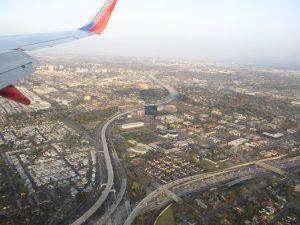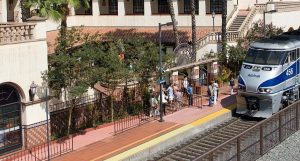
Santa Ana Freeway
As southern California grew, so did the traffic and roadways. Now many live along arterials and freeways where thousands of cars and trucks pass by every day, creating noise that permeates the surrounding neighborhoods. The City of Santa Ana is surrounded by four major freeways that carry hundreds of thousands of cars and trucks into and through the city every day. Sound walls help mitigate some of the noise, but nearby homes, schools, and parks must deal with persistent traffic noise. Shown above is a view of the Santa Ana Freeway looking southeast toward the Caltrans District 12 headquarters and Xerox Centre.
Photo courtesy of Ken Lund, CC By-SA 2.0
Approaching John Wayne Airport
The City advocates for flight paths to avoid residences and other sensitive land uses. Shown above is a plane flying over the Metro East Mixed-Use Overlay Zone, which permits a variety of residential, office, institutional, and commercial land uses.
Vibrant Restaurants, Bars, and Dance Club
The city has many lively places to eat, drink, dance, and listen to live music. Some parts of the city, like Downtown, are more compatible with businesses that stay open late and host live music, while other areas prefer to remain quieter.Noise Element

Music and Art
A band warms up before playing at the Santa Ana Art Walk in March 2017. The Artwalk is like a free carnival across downtown Santa Ana, with outdoor festival areas, art shows and performances, and live music. However, the festivities must come to an end at 10:00 pm to comply with the City’s current noise ordinance.
Community Input
Residents expressed a desire to maintain quiet neighborhoods and reduce noise related to traffic and excessively loud businesses during all phases of the General Plan preparation, including at events such as the 2016 community workshop (pictured above) and focused input such as the 2017 General Plan Advisory Group meeting.
Santa Ana Regional Transportation Center
The City’s primary transit center generates noise through the arrivals and departures of Amtrak (Pacific Surfliner shown above) and Metrolink trains, as well as Greyhound and OCTA buses.
Industrial Uses Near Residential Neighborhoods
Some neighborhoods in Santa Ana must contend with the impacts of living nearby industrial districts, including noise from the daily operations of uses such as trash-sorting facilities, auto service and salvage businesses, and metal-processing facilities.